El surf es un deporte apasionante, apreciado por la emoción de surfear las olas, pero también conlleva ciertos riesgos; naturalmente, surge la pregunta: “¿ Es peligroso el surf ? ”. Este artículo se centra en desafíos como las fuertes corrientes oceánicas y el encuentro con animales marinos. No se trata solo de destacar los peligros; también analizamos las medidas de seguridad y las prácticas de surf responsables. Ya sea que recién estés comenzando o seas un profesional experimentado, estos conocimientos están aquí para que tu experiencia de surf sea más segura y placentera.
Los 13 riesgos más comunes al practicar surf
El surf, un deporte que muchos adoran por su combinación de emoción y conexión con la naturaleza, también conlleva posibles riesgos. Al abordar las preguntas “ ¿Qué tan peligroso es el surf ?” y “¿ Es peligroso el surf ?”, nos centramos en los 13 riesgos más comunes de esta emocionante actividad.
1. Ahogamiento
Este riesgo surge principalmente cuando las fuertes olas mantienen a los surfistas bajo el agua o si se cansan demasiado de nadar contra la corriente.
La mejor manera de mitigar este peligro es elegir olas que coincidan con el nivel de habilidad del surfista, mantener la forma física y tener siempre un compañero de surf.
2. Colisiones
Las colisiones son un peligro común en el surf. Ocurren cuando los surfistas chocan entre sí, chocan contra rocas o chocan con sus propias tablas.
Los surfistas también suelen resultar heridos por sus propias tablas, especialmente por las afiladas aletas y la punta, lo que puede provocar cortes graves.
Para reducir el riesgo de estos accidentes, elija lugares de surf apropiados según su nivel de habilidad, manténgase constantemente atento a los alrededores y a otros surfistas, siga Reglas de surf , incluidas las reglas de "derecho de paso", uso de correas de surf y considerar el uso de equipo de protección como cascos en situaciones de alto riesgo. Respetar a otros surfistas y el espacio compartido en el agua para reducir los riesgos de colisión y mantener un entorno de surf seguro.
3. Tiburones
Si bien estadísticamente son poco frecuentes, los encuentros con tiburones son un riesgo que los surfistas deben tener en cuenta mientras están en el agua.
La sombra de un surfista sobre una tabla a veces puede ser confundida por los tiburones con la sombra de una foca, especialmente cuando la ven desde abajo.
La mayoría de los encuentros con tiburones no terminan en un ataque y muchos surfistas surfean durante años sin ver jamás un tiburón.
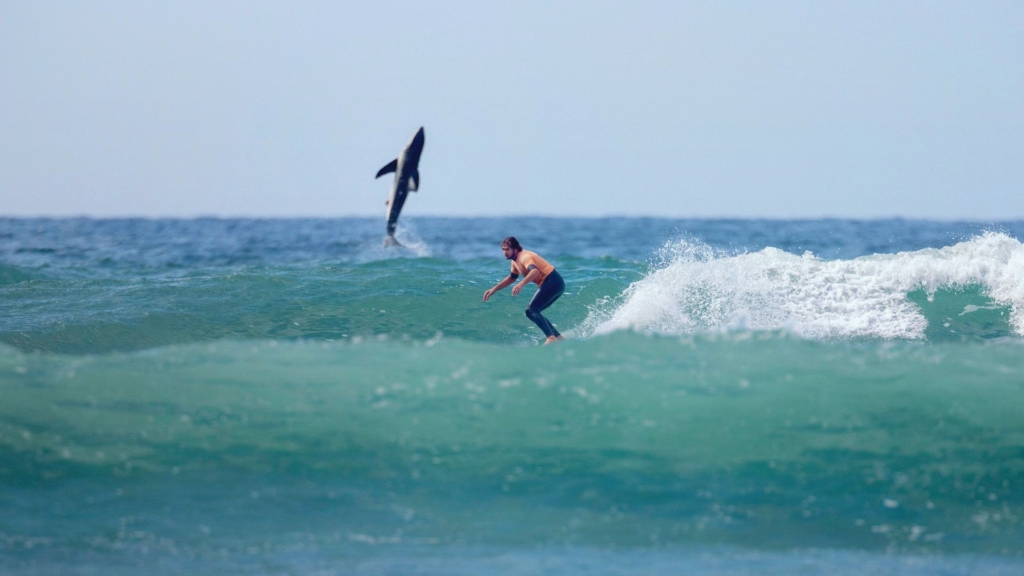
4. Corrientes y resacas
Las corrientes y las resacas plantean riesgos importantes, ya que son fuertes y dirigidas. Tienen el potencial de llevar rápidamente a un surfista al mar y hacer que regresar a la costa sea un gran desafío.
Estas situaciones pueden provocar un agotamiento rápido y, en casos extremos, aumentar el peligro de ahogamiento.
Para mantenerse a salvo, los surfistas deben observar el agua antes de entrar para detectar áreas irregulares que indiquen resacas. Es importante que, si se encuentra en medio de una corriente fuerte, se calme y nade hacia el otro lado, no en contra, y luego espere a que amaine antes de remar de regreso a la orilla.
5. Encuentros con la vida marina
Encontrar vida marina como tiburones, focas, medusas y erizos de mar es parte del surf en el diverso ecosistema del océano.
La probabilidad de que un tiburón ataque a la población mundial de surfistas, estimada en 35 millones, es increíblemente baja: solo un 0,00018 %. Sin embargo, los surfistas deben estar atentos en el agua. Si se encuentran con animales marinos potencialmente peligrosos, algo que ocurre raramente, la medida más segura es salir del agua lo antes posible.
6. Energía de las olas
Las olas son poderosas e impredecibles y pueden provocar lesiones por caídas o golpes en la tabla de surf. Una ola grande tiene una fuerza considerable, lo que hace que maniobras como el salto de pato sean casi imposibles. Además, cuando una ola de este tipo se rompe, puede suponer graves riesgos, como fracturas óseas, inmersión prolongada bajo el agua e incluso el impacto de los surfistas contra el fondo del océano.
La dinámica del océano puede ser especialmente desafiante para quienes no están familiarizados con él. Los surfistas deben conocer las condiciones de las olas del día y sus límites para mantenerse seguros. Elegir olas que sean adecuadas para su nivel de experiencia reducirá las posibilidades de lastimarse.
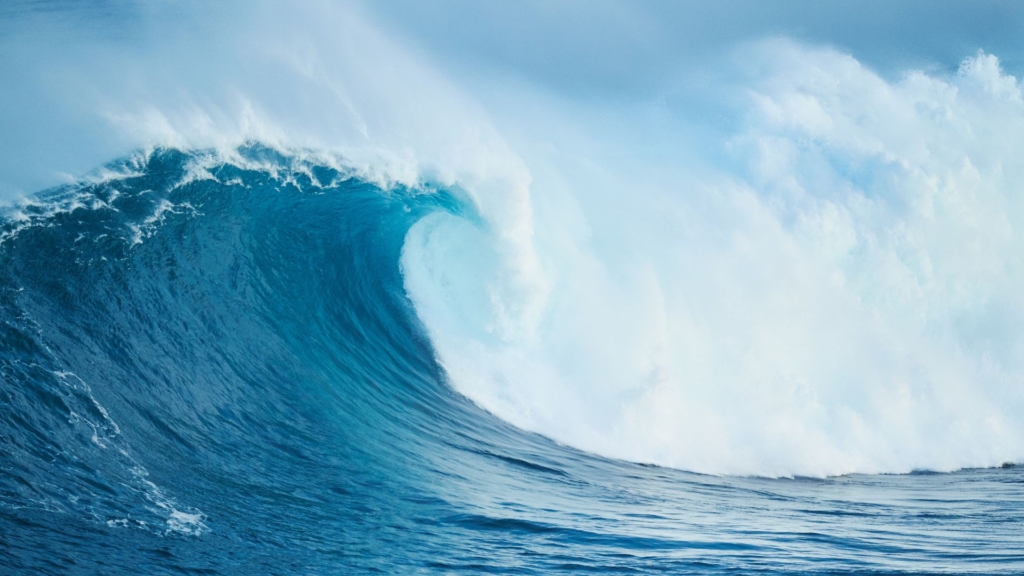
7. Lesiones en la tabla de surf
El localismo en el surf se refiere al comportamiento territorial de los surfistas que viven cerca de una zona de surf en particular. A menudo se manifiesta como resentimiento hacia los surfistas de otras regiones y desaliento activo a su participación.
8. Localismo
El localismo en el surf se refiere al comportamiento territorial de los surfistas que viven cerca de una zona de surf en particular. A menudo se manifiesta como resentimiento hacia los surfistas de otras regiones y desaliento activo a su participación.
Esta forma de territorialidad puede generar entornos hostiles, en particular en las zonas de surf más populares. El sentimiento de “nosotros contra ellos” prevalece en zonas con olas de mayor amplitud, donde el localismo puede afectar negativamente a la cultura y la experiencia del surf en general. Comprender la cultura del surf local y respetar a los surfistas locales y sus costumbres es esencial para navegar en el localismo.
9. Principiantes y surfistas irrespetuosos
Los principiantes, o "chiflados", como a veces se les llama, enfrentan desafíos en el surf, particularmente cuando desconocen las estrictas reglas de este deporte.
Errores como entrar al agua sin evaluar las condiciones, ignorar a los lugareños e intentar surfear más allá del propio nivel de habilidad pueden provocar accidentes y conflictos.
Además, la mala etiqueta, como robar olas o bloquear a otros surfistas, puede crear tensión en el agua.
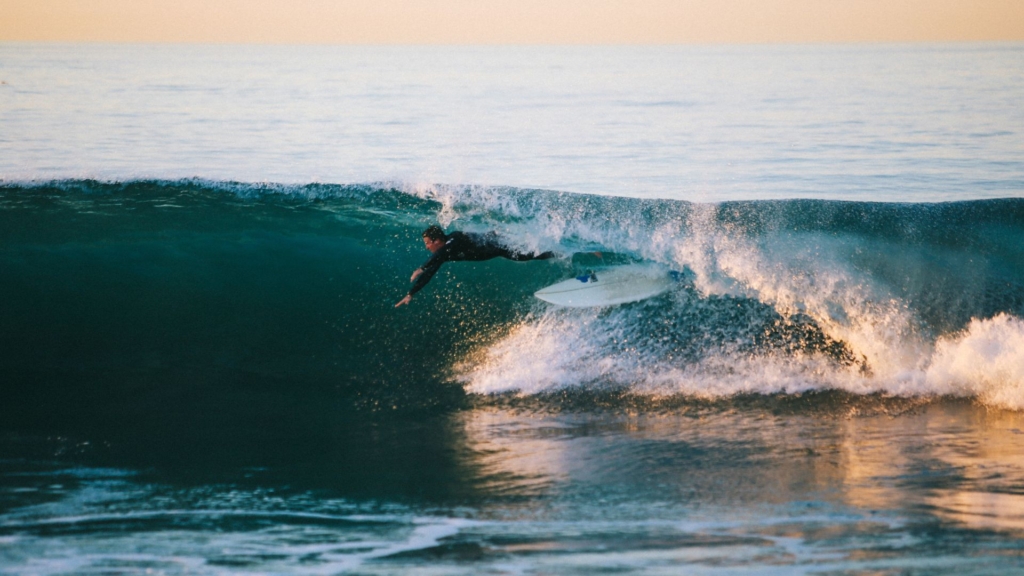
10. Hipotermia
Los surfistas se enfrentan a dos grandes riesgos relacionados con la temperatura: la hipotermia en aguas frías y la insolación por exceso de esfuerzo o por el sol. La hipotermia puede producirse en aguas frías, lo que provoca escalofríos, confusión y cansancio extremo. Es un problema importante, sobre todo durante sesiones de surf prolongadas.
Por otro lado, también existe el riesgo de sufrir un golpe de calor, que puede producirse por esforzarse demasiado en el agua o pasar demasiado tiempo al sol. Para mantenerse seguros mientras practican surf, los surfistas deben tener en cuenta ambos extremos: el frío del agua y el calor que produce el esfuerzo físico o la exposición al sol.
11. Exposición al sol
Pasar mucho tiempo navegando significa exponerse mucho al sol, y esto aumenta las probabilidades de padecer cáncer de piel, incluido el carcinoma de células basales, como destaca la Academia Estadounidense de Médicos de Familia.
Es una buena opción utilizar un protector solar resistente al agua con un FPS mínimo de 30 para reducirlo. Aplícalo unos 20 minutos antes de exponerte al sol. No olvides protegerte la cara, las orejas y el cuello con un sombrero de ala ancha para mayor protección. Planifica tu sesión de surf para las primeras horas de la mañana o las últimas horas de la tarde, cuando el sol no es tan fuerte. De esta manera, puedes enfrentarte a las olas y seguir teniendo cuidado con la protección solar.
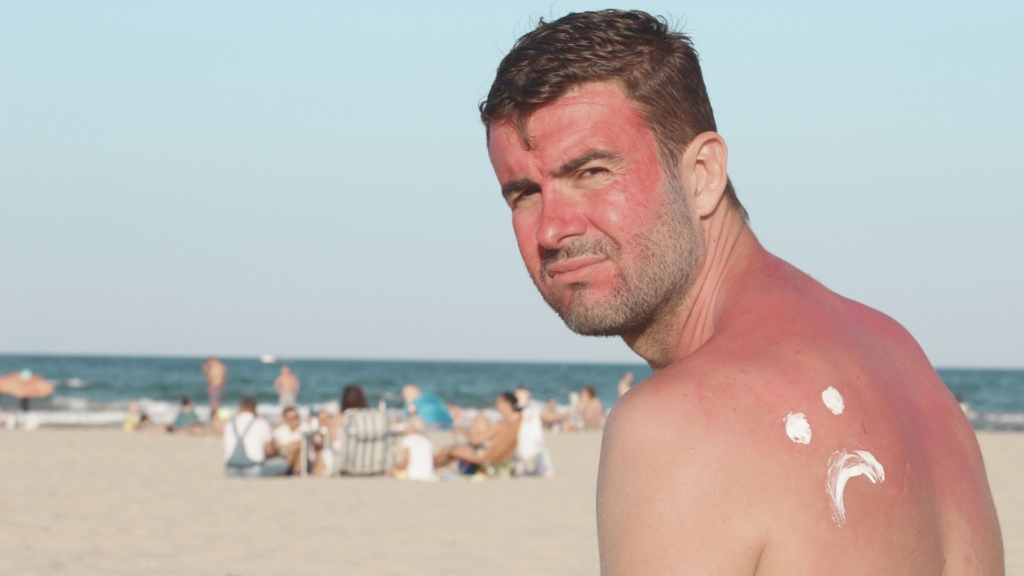
12. Infecciones del oído y oído de surfista
El riesgo de infecciones de oído y de oído de surfista para los surfistas proviene principalmente de la exposición constante y prolongada al agua fría y al viento.
Este problema se produce cuando se desarrollan crecimientos óseos inusuales en el canal auditivo, que pueden atrapar agua y bacterias, lo que provoca infecciones de oído y problemas de audición. Cuanto más tiempo pasa un surfista en agua fría, mayor es el riesgo.
La prevención incluye evitar condiciones de frío o viento extremos y mantener los oídos calientes y secos utilizando equipo de protección.
13. Impacto con el fondo marino
La práctica del surf conlleva riesgos asociados al entorno oceánico, incluidos los impactos en el fondo marino. Según el experto Andrew Nathanson, citado en Mpora.com, el 18% de las lesiones por surf se producen al impactar con el fondo marino.
Las lesiones en la cabeza y la columna vertebral suponen riesgos importantes, especialmente al surfear en olas potentes que rompen en aguas poco profundas.
¿Qué tan peligroso es el surf?
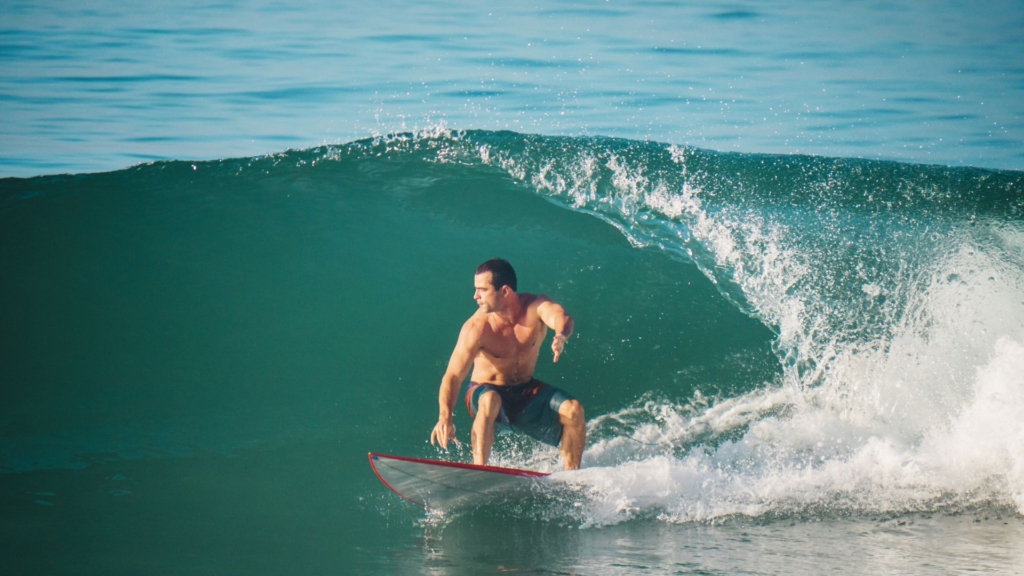
El surf conlleva un riesgo inherente de sufrir lesiones. Sin embargo, la tasa general de lesiones es relativamente baja, y oscila entre 2,2 y 3,5 lesiones por cada 1.000 días de surf, como se indica en el último informe de Gitnux. En cuanto a las muertes por surf, aunque no hay datos exactos al respecto, las estimaciones sugieren que no hay más de 10 muertes por año entre aproximadamente 23 millones de surfistas en todo el mundo; esta tasa también es una cifra notablemente baja.
De estas estadísticas se desprende claramente que el surf es, en general, más seguro que muchos otros deportes acuáticos y de contacto, aunque no está exento de riesgos.
Si nos fijamos en los detalles, aproximadamente el 72,7 % de los surfistas sufren lesiones, principalmente laceraciones (60-70 %) y lesiones en la cabeza (36,8 %). Las colisiones con otros surfistas causan alrededor del 36 % de estas lesiones, mientras que el 38,5 % se producen durante actividades como remar o coger olas. Esto subraya la necesidad de que los surfistas aprendan medidas de seguridad y reciban la formación adecuada para reducir estos riesgos.
11 consejos de seguridad para surfear
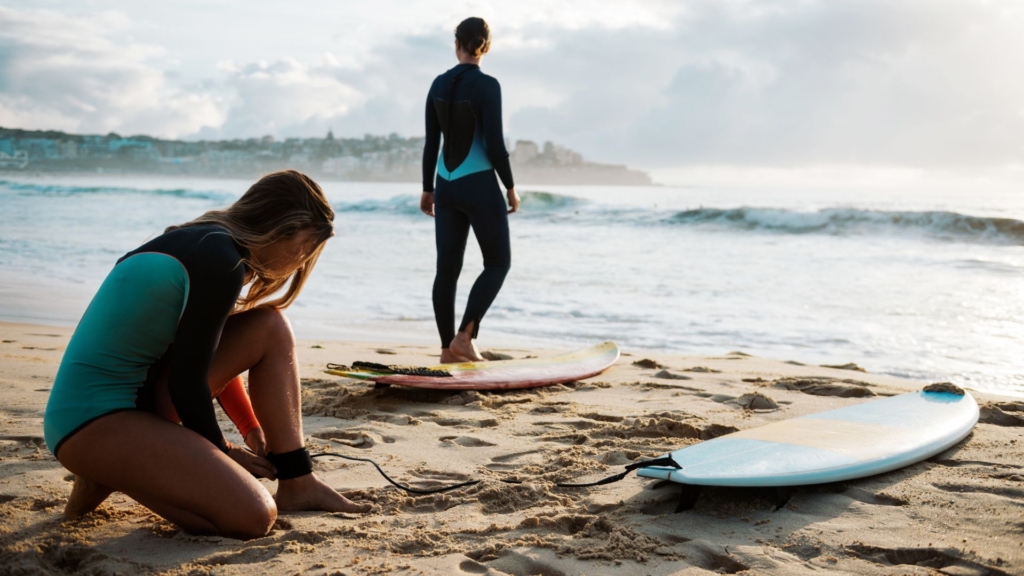
El surf es un deporte apasionante que te conecta con el poder y la belleza del océano. Sin embargo, es fundamental priorizar seguridad en el surf para garantizar una experiencia placentera y sin lesiones siguiendo estos consejos.
- Use una correa: Esto mantiene su tabla cerca y evita que se convierta en un peligro para los demás.
- Utilice protección solar: Proteja su piel con protector solar, una camiseta protectora contra erupciones o un traje de neopreno y considere usar un sombrero para una cobertura adicional.
- Conozca sus límites: Surfea dentro de tu nivel de habilidad y desafíate gradualmente con olas más grandes.
- Comprenda las corrientes de resaca: Aprenda a identificar y navegar de forma segura fuera de las corrientes de resaca.
- Surfea con un compañero: Tenga siempre consigo al menos una persona para su seguridad y asistencia.
- Manténgase atento a su entorno: Esté atento a las condiciones del océano y a otros surfistas para evitar accidentes.
- Calentar adecuadamente: Realice ejercicios de estiramiento y calentamiento para prevenir lesiones.
- Revise su equipo: Asegúrate de que tu tabla de surf y tus aletas estén en buenas condiciones antes de partir.
- Escuche a los lugareños: Tenga en cuenta los consejos de los surfistas locales sobre los peligros y condiciones específicos de la zona.
- Mantente hidratado: Bebe agua regularmente para prevenir la deshidratación, especialmente en los días calurosos.
- Aprenda primeros auxilios básicos: Familiarícese con cómo tratar lesiones comunes relacionadas con el surf, como cortes y picaduras de mar.
Siguiendo estas pautas, estar preparado y ser cauteloso te ayudará a disfrutar de las olas con tranquilidad.
Atrapa las olas Innovación
Como cualquier deporte, el surf conlleva riesgos, pero por lo general no es tan peligroso como suele pensarse cuando se pregunta “ ¿Es peligroso el surf ?”, especialmente si se toman las medidas de seguridad y se toma la debida conciencia.
La aleta Boost Surfing Fin lidera la carga en tecnología de surf notable y segura; esta aleta eléctrica, fácilmente acoplable a cualquier tabla en aproximadamente 5 minutos, ofrece un rendimiento mejorado con características como 20 libras de empuje, velocidades de hasta 10 mph y elementos de seguridad.
También viene con un control remoto y una aplicación para configuraciones personalizables, lo que contribuye significativamente a una experiencia de navegación más segura y eficiente. Por lo tanto, para aquellos interesados en mejorar su experiencia de navegación con una capa adicional de seguridad, explore Impulsar la navegación para atrapar una ola que perdure en la memoria.


Compartir:
¿Cómo generar velocidad de surf en una tabla de surf?
13 consejos de seguridad para surfear y vivir una aventura segura